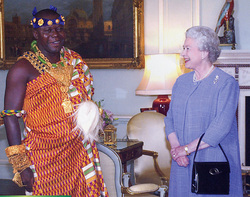....a special infusion of ethnic elegance and cultural sophistication into the babywearing scenery'  Introducing our ethnic woven wrap design-The Kente woven wrap sling With this design, a traditional African design meets the modern British weaving. This is an infusion of a popular ethnic design into the babywearing scenery. We’ve had a look around and we can safely say that we are the first company to commission the weaving of the popular Kente design in the United kingdom. The Kente cloth is originally handwoven in West Africa and we have been liaising with some Ghanaian weavers to see how we can re-engineer the hand-woven Kente cloth into wraps but we now decided to  bring the design into the UK and experiment the weaving of the design on the Hattersley Loom woven by our UK master weaver. Kente comes in diverse colours and we will be weaving this on a barley white warp with a black or green weft 100% combed cotton initially. Within the Kente symbolism, black derives its significance from the notion that new things get darker as they mature and physical aging comes with spiritual maturity. The Akan people of Ghana often blacken most of their ritual objects to increase their spiritual potency. Black symbolizes an intensified spiritual energy, communion with the ancestral spirits , antiquity, spiritual maturity and spiritual potency. While white denotes vitality and balance. The pattern in our current collection is composed of the Nkyinkyin and the Babadua. The Nkyinkyin is a zig zag pattern which signifies that ‘life is not straight’ and the Babadua which stands for strength toughness, reslinecy and superiority’ This indeed is a celebration of ethnic sophistication.  History of the Kente design Kente cloth, traditionally made by the people of Ghana, is very beautiful and meaningful. It is made by weaving long strips that contain symbolic patterns. There is a pattern to illustrate joy, a pattern for royalty, a pattern for newborn babies—nearly every important event in a person’s life can be expressed in Kente cloth patterns. When several strips of fabric are woven, they are cut into even lengths, and then stitched together to create wide sheets of cloth.  Although Kente, as we know it was developed in the 17th Century A.D. by the Ashanti people, it has it roots in a long tradition of weaving in Africa dating back to about 3000 B.C. The origin of Kente is explained with both a legend and historical accounts. A legend has it that a man named Ota Karaban and his friend Kwaku Ameyaw from the town of Bonwire (now the leading Kente weaving center in Ashanti), learned the art of weaving by observing a spider weaving its web.  Taking a clue from the spider, they wove a strip of raffia fabric and later improved upon their skill. They reported their discovery to their chief Nana Bobie, who in turn reported it to the Asantehene (The Ashanti Chief) at that time. The Asantehene adopted it as a royal cloth and encouraged its development as a cloth of prestige reserved for special occasions.  Kente is more than just a cloth. Like most of Africa's visual art forms, Kente is a visual representation of history, philosophy, ethics, oral literature, religious belief, social values and political thought. Originally, its use was reserved for their royalty and limited to special social and sacred functions. When its production increased, it became more accessible to those who could afford to buy it. However, its prestigious status was maintained, and it has continued to be associated with wealth, high social status and cultural sophistication. Today, in spite of the proliferation of both the handwoven and machine printed Kente, the authentic forms of the cloth are still regarded as a symbol of social prestige, nobility and a sense of cultural sophistication. According to Akan traditional protocol, Kente is reserved for very important and special social or religious occasions. Originally, it was not meant to be used for commonplace daily activities or as an ordinary wear. Its use for making clothing accessories was limited to items deemed scared or special and were used only for special occasions. In many cases the use of Kente has a sacred intent. It may be used as a special gift item during such rites and ceremonies as child naming, puberty, graduation, marriage and soul-washing. its significance as a symbol of prestige, gaiety and glamour is evident during such community celebrations as festivals and commemoration of historical events, when people proudly wear the best of their Kente Cloths to reflect the spirit of the occasion  Kente is used not only for its beauty but also for its symbolic significance. Each cloth has a name and a meaning; and each of the numerous patterns and motifs has a name and a meaning. Names and meanings are derived from historical events, individual achievements, proverbs, philosophical concepts, oral literature, moral values, social code of conduct of conduct, human behavior and certain attributes of plant and animal life. Patterns and motifs are rendered in geometric abstractions of objects associated with the intended meaning. Sometimes some of such patterns and motifs are arbitrarily determined, and their forms have no direct structural similarities with the concepts or objects symbolized. Their relationship is primarily conceptual rather than representational. Patterns and motifs are generally created by weavers who also assign names and meanings to them. Forms, names and means of such patterns and motifs are sometimes given by weavers who may obtain them through dreams and during contemplative moments when they are said to be in communion with the spiritual world. Sometimes, kings and elders may ascribe names to cloths that they specially commission. Generally, names are based on the warp arrangements of the cloth, however, in some instances, both warp and weft arrangements determine a name of a cloth.  There are over 300 different types of cloth designs, each with its name. Each cloth design comes with numerous variations-in color and distribution of motifs. This chart presents names of 54 different cloth designs, and 42 motifs, their literal meanings and their symbolic significance. Symbolism are given interpretations on the basis of the general Akan culture. Color symbolism within the Akan culture affects the aesthetics of Kente. Colors are chosen for both their visual effect and their symbolic meanings. A weaver's choice of colors for both weft and warp designs, may be dictated either by tradition or by individual aesthetic taste. There are gender differences in color preferences, dictated by tradition, individual aesthetic taste and by spirit of the occasion. As a convention rather than a strict code of dress, women tend to prefer cloths with background or dominant colors that are lighter or tinted, such as white, light yellow, pink, purple, light blue, light green and turquoise. Generally, men tend to prefer cloths with background or dominant colors that are on the shaded side, such as black, dark blue, dark green, maroon, dark yellow, orange and red. Social changes and modern living have, however, led some people to ignore these traditional norms, resulting in color choice based on individual taste. Conclusively, we hope that the Kente woven wrap design will bring a fresh air of cultural elegance into the babywearing scenery . This indeed is a celebration of ethnic sophistication. A sneak peak into our new and intriguing ethnic woven wraps woven right here in the UK
1 Comment
Esther
12/19/2019 06:39:33 pm
I’m looking for woven baby wraps /Sling in bulk.Contact me through [email protected]
Reply
Leave a Reply. |
Archives
May 2023
AuthorHello, my name is Bisi, babywearing consultant (SoB CIC), mother to two cheeky & very special kids (Joy and Joseph). Our 3rd baby has been christened Joy&Joe baby wrap slings! and we loveeee babywearing :) |
Joy and Joe® is a registered trademark that belongs to Joy and Joe limited . We are registered in England and Wales. Company registration number 08495654.
VAT number GB277613674
VAT number GB277613674
|
Joy and Joe Ltd,
64 Junction Lane, WA9 3JN, Sutton, St Helens. |













 RSS Feed
RSS Feed





